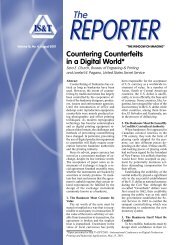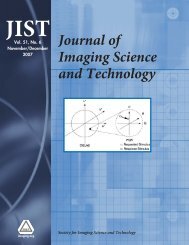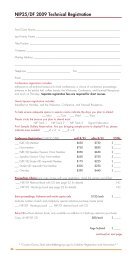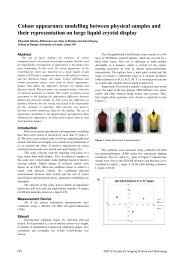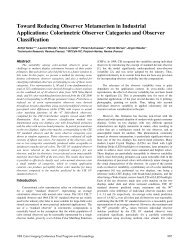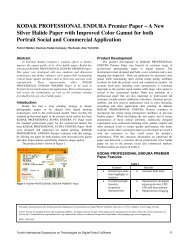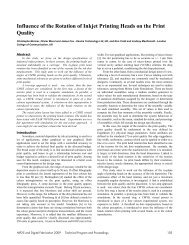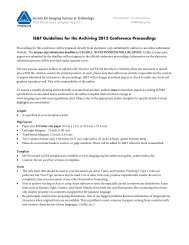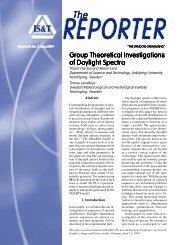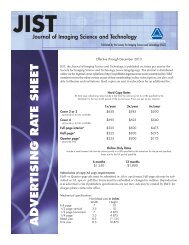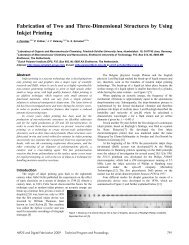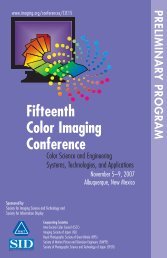Archiving 2012 Preliminary Program - Society for Imaging Science ...
Archiving 2012 Preliminary Program - Society for Imaging Science ...
Archiving 2012 Preliminary Program - Society for Imaging Science ...
You also want an ePaper? Increase the reach of your titles
YUMPU automatically turns print PDFs into web optimized ePapers that Google loves.
PReLIMINARy<br />
PROGRAM<br />
Sponsored by<br />
<strong>Society</strong> <strong>for</strong> <strong>Imaging</strong> <strong>Science</strong> and Technology<br />
IS&T<br />
imaging.org<br />
<strong>Archiving</strong> <strong>2012</strong><br />
June 12-15, <strong>2012</strong><br />
Copenhagen, Denmark<br />
PRELIMINARY<br />
PROGRAM<br />
General Co-chairs:<br />
Mogens Koch, Royal Danish Academy of Fine Arts<br />
Jonas Palm, National Archives of Sweden<br />
www.imaging.org/ist/conferences/archiving<br />
In cooperation with<br />
AIC The American Institute <strong>for</strong> Conservation of Historic & Artistic Works<br />
ALA ALCTS American Library Association-Association <strong>for</strong> Library Collections<br />
& Technical Services<br />
CNI Coalition <strong>for</strong> Networked In<strong>for</strong>mation<br />
IOP/Printing and Graphic <strong>Science</strong>s Group<br />
ISCC Inter-<strong>Society</strong> Color Council<br />
RPS Royal Photographic <strong>Society</strong>/<strong>Imaging</strong> <strong>Science</strong> Group<br />
Photo: Suzanne Grinnan.
Conference Overview/Highlights<br />
General Chairs<br />
Mogens Koch, The Royal Danish<br />
Academy of Fine Arts<br />
Jonas Palm, National Archives of<br />
Sweden<br />
<strong>Program</strong> Chairs<br />
Peter Burns, Burns Digital<br />
<strong>Imaging</strong><br />
Volker Märgner, Technische<br />
Universität Braunschweig<br />
Short Course Chair<br />
Ulla Kejser, The Royal Library,<br />
Denmark<br />
Publicity Chair<br />
Larry Tel<strong>for</strong>d, FamilySearch<br />
Technical <strong>Program</strong> Committee<br />
Paul Conway, University of<br />
Michigan<br />
Hans Hofman, Nationaal Archief<br />
Netherlands<br />
Erik Landsberg, Musuem of<br />
Modern Art<br />
Steven Puglia, US Library of<br />
Congress<br />
Judith Rog, Koninklijke<br />
Bibliotheek<br />
Stanley R. Smith, J. Paul Getty<br />
Museum<br />
Simon Tanner, King’s College<br />
London<br />
Larry N. Tel<strong>for</strong>d, FamilySearch<br />
Manfred Thaller, Universität Zu<br />
Koln<br />
Christoph Voges, consultant<br />
Dietmar Wueller, Image<br />
Engineering GmbH & Co. KG<br />
June 12-15 • Copenhagen, Denmark<br />
Copenhagen—a gateway to Scandinavia and the capitol of Denmark—hosts <strong>Archiving</strong> <strong>2012</strong>.<br />
This vibrant city has been inhabited since the 8th century AD. A multitude of districts, each<br />
representing its own time and distinctive character, makes the city a wonderful place to<br />
explore as well as enjoy the many water views, parks, and bicycle paths that line most streets.<br />
The historic atmosphere mixed with a modern city offers attendees a distinctive and interesting<br />
setting to learn from peers about effective digital archiving approaches, workflows,<br />
processes, and solutions that cultural heritage institutions are facing and addressing.<br />
The conference put together by this year’s <strong>Program</strong> Chairs ensures a technically productive<br />
meeting that balances an exciting papers program with fun and interesting networking events.<br />
Highlights include:<br />
• 11 short courses, including four that have never been taught at <strong>Archiving</strong> (see page 6)<br />
• Welcome Reception at the School of Conservation. (see page 2)<br />
• Two timely keynotes, 43 oral, and 21 interactive technical papers (see page 14)<br />
• A Conference Dinner held at Kulturhuset Islands Brygge with a view of the harbor toward<br />
the city center. (see page 2)<br />
• Four fascinating behind-the-scene tours (see page 4)<br />
We hope you will join us <strong>for</strong> this exciting week and look <strong>for</strong>ward to seeing you in June!<br />
©<strong>2012</strong> <strong>Society</strong> <strong>for</strong> <strong>Imaging</strong> <strong>Science</strong> and Technology (IS&T).<br />
—Mogens S. Koch and Jonas Palm, General Co-chairs<br />
Conference Committee<br />
Steering Committee<br />
Robert Buckley, University of<br />
Rochester / NewMarket <strong>Imaging</strong><br />
Franziska Frey, Rochester Institute<br />
of Technology<br />
Suzanne E. Grinnan, IS&T<br />
Mogens Koch, The Royal Danish<br />
Academy of Fine Arts<br />
Wayne Metcalfe, FamilySearch<br />
Jonas Palm, National Archives of<br />
Sweden<br />
Kate Zwaard, US Library of<br />
Congress<br />
IS&T Conference Organization<br />
Sabine Süsstrunk, EPFL,<br />
Conference Vice President<br />
Suzanne E. Grinnan,<br />
Executive Director<br />
Diana Gonzalez,<br />
Conference <strong>Program</strong> Manager
<strong>Archiving</strong> <strong>2012</strong><br />
Conference At-a-Glance<br />
All technical session will take place at Nationalmuseet (National Museum).<br />
Short Courses take place at the School of Conservation at the Royal Academy of<br />
Fine Arts Schools of Architecture, Design, and Conservation (see page 6).<br />
Registration Hours<br />
Tues., June 12, 7:30 – 15:45 @School of Conservation (Tues only)<br />
Wed., June 13, 7:30 – 15:00 @Nationalmuseet (Wed. - Fri.)<br />
Thurs., June 14, 7:45 – 14:00 Fri., June 15, 7:45 – 13:00<br />
Tuesday, June 12<br />
• Short Course <strong>Program</strong> (see p. 6)<br />
• Welcome Reception at the School of<br />
Conservation (see p. 2)<br />
Wednesday, June 13<br />
• Keynote by James M. Reilly, Director,<br />
Image Permanence Institute<br />
• Conference Exhibit<br />
• Technical Papers <strong>Program</strong><br />
• Building Digital Assets<br />
• Colour<br />
• Exhibitor Previews<br />
• Interactive Papers<br />
• Free evening to explore Copenhagen<br />
Thursday, June 14<br />
• Technical Papers <strong>Program</strong><br />
• Workflow and Metadata Creation<br />
• 3D <strong>Imaging</strong> and Standards<br />
• IQ Testing and Standards<br />
Table of Contents<br />
Conference Overview . . . . . . . . . . . . . . i<br />
Conference At-a-Glance . . . . . . . . . . . . 1<br />
Venue . . . . . . . . . . . . . . . . . . . . . . . . . 2<br />
Special Events . . . . . . . . . . . . . . . . . . . .3<br />
Behind-the-Scenes Tours . . . . . . . . . . . . . 4<br />
Accommodation In<strong>for</strong>mation . . . . . . . . . 5<br />
Short Course <strong>Program</strong> . . . . . . . . . . . . . . 6<br />
Short Courses At-a-Glance . . . . . . . . . . . 7<br />
Technical <strong>Program</strong> . . . . . . . . . . . . . . . 14<br />
Conference Registration . . . . . . back cover<br />
• Behind-the-Scenes Tours (see p. 4)<br />
• Conference Dinner at the Kulturhuset<br />
Islands Brygge (see p. 2)<br />
Friday, June 15<br />
• Keynote by John A. Aarons, University<br />
Archivist, The University of the<br />
West Indies, Jamaica<br />
• Technical Papers <strong>Program</strong><br />
• Collaboration and Costs<br />
• Novel Capture<br />
• Compliance<br />
• Image Processing and JPEG 2000<br />
IS&T thanks<br />
Royal Danish Academy of<br />
Fine Arts and<br />
National Museum of Denmark<br />
<strong>for</strong> their support of <strong>Archiving</strong> <strong>2012</strong>.<br />
We also acknowledge the<br />
<strong>Archiving</strong> <strong>2012</strong> exhibitors:<br />
HASSELBLAD<br />
Image Engineering GmbH & Co. KG<br />
JVC Advanced Media EUROPE GmbH<br />
Cover image: The Nyhavn area of Copenhagen<br />
is a favorite with tourists. Lined with outdoor<br />
dining, there are many hotels nearby.<br />
1
2<br />
Copenhagen<br />
Copenhagen, the capitol of Denmark and<br />
home to the famous Little Mermaid statue, is<br />
a very modern city juxtaposed with its historic<br />
past. Recognized as offering one of the best<br />
qualities of life, as well as being one of the<br />
world's most environmentally friendly cities,<br />
Copenhagen is easy to navigate whether on<br />
foot, Metro, bus, or bicycle.<br />
The conference venue is well situated to<br />
many of the city’s cultural offerings including<br />
The Royal Library, The National Gallery, the<br />
Danish Museum of Art and Design,<br />
Rosenborg Castle Gardens (established in<br />
the early 17th century), and the world<br />
famous Tivoli Gardens and amusement park.<br />
Smörgåsbord (sandwiches; see page 3) and<br />
Denmark’s famous Carlsberg beer are just<br />
two of the culinary highlights the city has to<br />
offer.<br />
See www.visitcopenhagen.com/ <strong>for</strong> more<br />
in<strong>for</strong>mation on the city and planning your<br />
visit.<br />
Participate in the<br />
<strong>Archiving</strong> <strong>2012</strong><br />
Exhibition<br />
An exhibition featuring digital archiving<br />
related products and services will run all<br />
day Wednesday in the same space as the<br />
coffee break and Interactive Papers<br />
Session.<br />
For details, contact Donna Smith<br />
dsmith@imaging.org<br />
+1-703-642-9090 x107<br />
June 12-15 • Copenhagen, Denmark<br />
Conference Venues<br />
School of Conservation<br />
(Konservatorskolen)<br />
Tue. June 12 various times (see page 6)<br />
Short Courses<br />
Tue. June 12, 17:30 – 19:00<br />
Welcome Reception<br />
Located at Esplanaden 34, past the Amalie<br />
Palace and near the Kastellet. The School is<br />
a lovely ~20-minute walk from Nyhavn; ~30<br />
minutes from the Nationalmuseet. The nearest<br />
train station is Østerport, which is a 10<br />
minute walk. Buses 1A, 15, and 19 stop on<br />
Esplanaden.<br />
National Museum of Denmark<br />
(Nationalmuseet)<br />
Wed. June 13 to Fri. June 15<br />
Technical Sessions (see page 14)<br />
Located at Frederiksholms Kanal 12. Buses<br />
1A, 2A, 5A, 11A, 12, 15, 26, 29, 33,<br />
650s, 901, and 902 stop nearby. Nearest<br />
train station is Central; nearest Metro<br />
station is Norreport.<br />
Kulturhuset Islands Brygge<br />
Thursday, June 14<br />
Conference Reception<br />
19:00-21:30<br />
Located across the river from downtown<br />
Copenhagen, Kulturhuset Islands Brygge<br />
(http://kubik.kk.dk/k-i-b) enjoys waterfront<br />
vies. Take bus 250s to Isafjordsgade, a 3<br />
minute walk from the reception site.
Photo: Suzanne Grinnan.<br />
<strong>Archiving</strong> <strong>2012</strong><br />
•<br />
•<br />
•<br />
•<br />
•<br />
LOCATIONS OF eveNTS<br />
Kobenhavns Hovebanegard<br />
(Central train station)<br />
Kongens Nytorv (Metro station;<br />
direct service from airport)<br />
Nationalmuseet / National Museum of<br />
Denmark (technical sessions)<br />
Konservatorskolen / School of<br />
Conservation<br />
(short courses and welcome reception)<br />
Kulturhuset Islands Brygge<br />
(conf. banquet)<br />
Outdoor dining abounds in Copenhagen in<br />
the Summer, and the smörgåsbord’s—which<br />
run the gamut from steak tartar to the herring<br />
salad seen here—are delicious.<br />
3
4<br />
Thursday, June 14, <strong>2012</strong><br />
Take advantagous of one of these unique<br />
Behind-the-Scenes Tours offered by the<br />
<strong>Archiving</strong> Conference. See box on page 5<br />
<strong>for</strong> details.<br />
The Royal Library, Department of<br />
Maps, Prints and Photographs<br />
The Royal Library is Denmark’s national<br />
library and the library <strong>for</strong> the University of<br />
Copenhagen. The tour takes place in the<br />
striking Black Diamond building and it focuses<br />
on how the library curates its national photographic<br />
collections.<br />
Using the current project “Europeana<br />
1914-1918” about the dissemination of<br />
source materials related to the First World<br />
War, staff illustrate the library’s overall policy<br />
and strategy <strong>for</strong> collection management and<br />
describe how the digital, as well as the analog<br />
lifecycle, is managed in practice. This includes:<br />
ingest and qualification of the collections;<br />
digitization and preservation; and<br />
research and dissemination. Participants<br />
hear about challenges and see examples<br />
from the library’s rich photographic collections.<br />
The visit includes a brief tour of the<br />
digitization lab.<br />
For more in<strong>for</strong>mation visit<br />
www.kb.dk/en/nb/samling/bs/index.html<br />
Danish National Archives<br />
The Danish National Archives collects and<br />
stores archival records from central government<br />
authorities, military <strong>for</strong>ces, the Danish<br />
Royal House, and private organizations and<br />
individuals. The collections date back to the<br />
12th century. Today there is about 250 kilometres<br />
of shelving. The tour visits the<br />
Archive‘s new storage facilities (not the historic<br />
main building), which has a capacity of<br />
~380 km of shelving. Uni<strong>for</strong>m barcoded boxes,<br />
trucks, and 12-meter high shelving create<br />
a modern facility that is expected to hold al-<br />
June 12-15 • Copenhagen, Denmark<br />
Behind-the-Scenes Cultural Institution Tours<br />
most all future accession of paper records<br />
created by the Danish government.<br />
The tour also includes an introduction to<br />
the digital archiving work of the Danish<br />
National Archives, which has a collection of<br />
~30 TB of born-digital data, with the amount<br />
growing. We visit the facilities <strong>for</strong> the reception,<br />
testing, and preservation of digital<br />
records, and discuss practical solutions <strong>for</strong><br />
keeping them.<br />
For more in<strong>for</strong>mation visit<br />
http://www.sa.dk/content/us/about_us/<br />
danish_national_archives<br />
Hasselblad<br />
Established in 1841 in Gothenburg, Sweden,<br />
Hasselblad is one of the best known makers<br />
of medium <strong>for</strong>mat cameras. Their most famous<br />
use was during the Apollo program<br />
missions when man first landed on the Moon.<br />
Almost all of the still photographs taken<br />
during these missions used modified<br />
Hasselblads.<br />
After a welcome and brief history of<br />
Hasselblad, participants will tour the facility<br />
and meet world famous photo-grapher<br />
Jorgen Angel, who will speak on the history<br />
of analog to digital photography. Angel is<br />
best known <strong>for</strong> his analog images of rock<br />
stars. Hasselblad staff also will be available<br />
<strong>for</strong> questions.<br />
For more in<strong>for</strong>mation visit<br />
http://www.hasselbladusa.com/ and<br />
http://www.angel.dk<br />
Behind the Scenes with Phase One<br />
Take advantage of this unique opportunity to<br />
visit Phase One headquarters, a leading<br />
manufacturer in high-end medium <strong>for</strong>mat<br />
digital photography. Sponsored by the<br />
Digital Transitions Division of Cultural<br />
Heritage in New York City, attendees will<br />
tour the Phase One facility including R&D,<br />
testing, and assembly. Also hear from Phase
<strong>Archiving</strong> <strong>2012</strong><br />
Accommodations and Transportation<br />
Accommodations<br />
There is no headquarter hotel <strong>for</strong> this meeting,<br />
however we have been able to secure some<br />
special rates at hotels near the confernece venues.<br />
We have posted this in<strong>for</strong>mation on the<br />
conference web page, with in<strong>for</strong>mation on<br />
and links to the properties. You may also want<br />
to explore various online booking sites like<br />
hotels.com to locate other accommodation<br />
options and the best rates.<br />
Please note that Denmark does not use the<br />
Euro, but the Kroner (DKK). At the time of printing,<br />
the exchange rate was approximately<br />
€1 ~ 7.5 DKK; $1 ~ 5.5 DKK<br />
To/From Copenhagen<br />
There are non-stop flights to Copenhagen<br />
International Airport (CPH) from many cities<br />
including Amsterdam, Barcelona, Chicago,<br />
Frankfurt, Madrid, New York, Paris,<br />
Washington, and Zurich. CPH is 8 km south<br />
of the city. For more in<strong>for</strong>mation visit<br />
www.cph.dk/CPH/UK/MAIN.<br />
One CEO, VP of R&D, and<br />
VP of Innovation & Application<br />
speak about the technology<br />
behind Phase products<br />
and how they work in various<br />
vertical markets including<br />
the cultural heritage<br />
community.<br />
For more in<strong>for</strong>mation visit<br />
www.phaseone.com and<br />
www.digitaltransitions.com<br />
Special Note on Tours<br />
To/From the Airport<br />
• From the airport, a taxa (taxi) to central<br />
Copenhagen will cost approximately<br />
DKK220.<br />
• Depending on your hotel location, the<br />
Metro is an easy travel option. The Metro<br />
station is located up an escalotor at the<br />
end of Terminal 3. It operates at 4-6<br />
minute intervals during most hours, and at<br />
15-20 minute intervals at night. Travel<br />
time from CPH to Nørreport Metro Station<br />
(in central Copenhagen) is 15 minutes.<br />
For more in<strong>for</strong>mation visit<br />
http://intl.m.dk/.<br />
• There is train service from CPH to<br />
Copenhagen Central Station every 20<br />
minutes; the journey takes 30 minutes. A<br />
one-way ticket (3 zones) costs DKK34.50.<br />
For more in<strong>for</strong>mation visit www.cph.dk/<br />
CPH/ UK/MAIN/ Parking+and+<br />
Transport/By+Train/<br />
• The link <strong>for</strong> in<strong>for</strong>mation on bus service is<br />
www.cph.dk/CPH/UK/MAIN/<br />
Parking+and+Transport/By+Bus.htm<br />
Advance registration is required; space is limited and reserved<br />
on a first-come first-served basis. Tour time is ~1.5-<br />
2 hours. Tours will end in time <strong>for</strong> participants to get to the<br />
Conference Reception.<br />
everyone who registers by the early registration deadline<br />
will receive more details on the tours, including directions<br />
on how to sign up <strong>for</strong> them immediately following that<br />
date. Others will receive details as they register. All tours<br />
are free, but participants are responsible <strong>for</strong> getting to the<br />
tour site on time. Transportation and other details will be<br />
provided on the tour registration <strong>for</strong>m. Those who do not<br />
wish to take a tour will have a free afternoon.<br />
5
6<br />
T1A: Digital Forensics <strong>for</strong> Acquisitions on<br />
Physical Media: Concepts and Methods<br />
Tuesday, June 12, <strong>2012</strong><br />
8:00 – 17:30 (8 hours)<br />
Instructor: Christopher (Cal) Lee,<br />
University of North Carolina, Chapel Hill<br />
In<strong>for</strong>mation professionals are often responsible<br />
<strong>for</strong> acquiring or helping others to access<br />
materials that reside on removal storage media,<br />
e.g. receiving disks as part of a collection.<br />
The in<strong>for</strong>mation is often not packaged<br />
and described as one would hope; the in<strong>for</strong>mation<br />
professional must extract whatever<br />
useful in<strong>for</strong>mation resides on the medium,<br />
while avoiding the accidental alteration of<br />
data or metadata. The field of digital <strong>for</strong>ensics<br />
offers many methods <strong>for</strong> data recovery<br />
and documentation. This course explores the<br />
layers of hardware and software that allow<br />
bitstreams on digital media to be read as<br />
files. Participants learn the roles and relationships<br />
of these layers and learn about tools<br />
and techniques <strong>for</strong> ensuring the completeness<br />
and evidential value of data.<br />
Benefits<br />
This course enables the attendee to:<br />
• Understand the roles and relationships<br />
between the main layers of technology<br />
required to read a string of bits off a<br />
physical storage medium and treat it as a<br />
file.<br />
• Learn about various <strong>for</strong>ms of data that<br />
may be “hidden” on the physical storage<br />
medium.<br />
• Recognize the “order of volatility” of data<br />
in computer systems and strategies <strong>for</strong> accidental<br />
manipulation of volatile data.<br />
• Delve into the data that a file system uses<br />
to manage files, focusing on FAT32 as a<br />
common example.<br />
• Gain an awareness of digital <strong>for</strong>ensics<br />
tools and techniques and learn where to<br />
find more in<strong>for</strong>mation about those tools<br />
and techniques.<br />
June 12-15 • Copenhagen, Denmark<br />
Short Course <strong>Program</strong>: Tuesday, June 12, <strong>2012</strong><br />
• Learn well-established practices <strong>for</strong> documenting<br />
the <strong>for</strong>ensic process, in order to<br />
ensure the evidential value of data.<br />
Intended Audience: in<strong>for</strong>mation professionals<br />
responsible <strong>for</strong> acquiring or transferring collections<br />
of digital materials, particularly<br />
those received on removable media.<br />
Christopher (Cal) Lee is associate professor at the<br />
School of In<strong>for</strong>mation and Library <strong>Science</strong> at the<br />
University of North Carolina, Chapel Hill. He teaches<br />
graduate and continuing education courses in<br />
archival administration, records management, digital<br />
curation, and in<strong>for</strong>mation technology <strong>for</strong> managing<br />
digital collections. His research focuses on curation<br />
of digital collections and stewardship of personal<br />
digital archives. Cal is PI <strong>for</strong> the BitCurator project<br />
and editor of I, Digital: Personal Collections in the<br />
Digital Era.<br />
T2A: Evaluating and Selecting Still Image File<br />
Formats and Compression <strong>for</strong> Digitization Projects<br />
8:00 – 12:15 (4 hours)<br />
Instructor: Steven Puglia, US Library of Congress<br />
Decisions on image file <strong>for</strong>mats and compression<br />
should reflect current perspectives, and<br />
will influence significantly an institution’s ability<br />
to produce, manage, preserve, and provide<br />
digital resources. The issues to be considered<br />
are not just technical, economic and<br />
fiscal implications need to be considered as<br />
well. This course covers criteria, guidelines,<br />
and methods <strong>for</strong> evaluating and selecting appropriate<br />
file <strong>for</strong>mats and image compression<br />
(lossless and lossy) <strong>for</strong> raster image files<br />
to be produced by digitization projects <strong>for</strong> a<br />
wide variety of collection content, including<br />
books, manuscripts, still photographs, maps,<br />
etc. Methods used <strong>for</strong> analyzing the effects of<br />
compression on image files and <strong>for</strong> determining<br />
appropriate and acceptable levels of<br />
compression <strong>for</strong> different collections and projects<br />
will be covered.
<strong>Archiving</strong> <strong>2012</strong><br />
8:00 – 12:15<br />
T3A: Scanner & Camera <strong>Imaging</strong> Per<strong>for</strong>mance:<br />
Benchmarking and Workflow Monitoring<br />
8:00 – 12:15<br />
T4A: Lessons Learned in Preservation Planning<br />
Short Courses At-a-Glance<br />
8:00 – 17:30<br />
T1A: Digital Forensics <strong>for</strong> Acquisitions on Physical Media: Concepts and Methods<br />
8:00 – 12:15<br />
T2A: Evaluating and Selecting Still Image File Formats<br />
and Compression <strong>for</strong> Digitization Projects<br />
8:00 – 10:00<br />
T5A: Intro. to Color <strong>for</strong><br />
Libraries, Archives . . .<br />
Descriptions <strong>for</strong> short courses begin on page 6.<br />
10:15 – 12:15<br />
T5B: Digital Preservation<br />
of Audiovisual Content<br />
Benefits<br />
This course enables the attendee to:<br />
• Learn about criteria and guidelines <strong>for</strong><br />
selecting image file <strong>for</strong>mats and compression,<br />
including sustainability factors and<br />
related confidence, costs, implementation,<br />
considerations, technical capabilities,<br />
verification and validation, and metadata<br />
support.<br />
• Understand methods of evaluating image<br />
compression, including visual or subjective<br />
assessment, metric or objective<br />
analyses, and task accuracy evaluations.<br />
• Appreciate context <strong>for</strong> ensuring decisions<br />
support key institutional considerations in<br />
the areas of cost-effectiveness, digital<br />
storage, IT infrastructure, and digital<br />
preservation.<br />
Intended Audience: managers, librarians,<br />
imaging practitioners, and anyone involved<br />
with planning, implementing, and managing<br />
digitization in cultural heritage organizations.<br />
Only general experience with digitization<br />
is recommended.<br />
13:15 – 17:30<br />
T2C: JPEG 2000 and JP2 <strong>for</strong><br />
Image Preservation and Access<br />
13:15 – 17:30<br />
T3C: Understanding Your Camera /<br />
Scanner and its Color Reproduction<br />
13:15 – 17:30<br />
T4C: The Identification and Preservation<br />
of Digital Prints<br />
13:15 – 15.15<br />
T5C: From Ingest to Access<br />
Using Archivematica<br />
15:30 – 17:30<br />
T5D: Metamorfoze<br />
Preservation . . .<br />
Steven Puglia is a digital conversion services manager<br />
in the Office of Strategic Initiatives at the US<br />
Library of Congress. He provides technical expertise<br />
<strong>for</strong> a wide range of projects involving the digital<br />
conversion of collections. In April 2011, Puglia began<br />
coordinating the Still Image Working Group of<br />
the Federal Agencies Digitization Guidelines Initiative.<br />
Previously, from 1988-2011, he worked as a<br />
preservation and imaging specialist at the US<br />
National Archives & Records Administration.<br />
T3A: Scanner & Camera <strong>Imaging</strong> Per<strong>for</strong>mance:<br />
Benchmarking and Workflow Monitoring<br />
8:00 – 12:15 (4 hours)<br />
Instructors: Peter Burns, Burns Digital <strong>Imaging</strong>,<br />
and Don Williams, Image <strong>Science</strong> Associates<br />
The course begins with a discussion of how to<br />
interpret customer requirements when selecting<br />
components <strong>for</strong> an image acquisition system.<br />
Several imaging principles that provide<br />
a background to understanding imaging per<strong>for</strong>mance<br />
in digital acquisition and conversion<br />
are then introduced. The use and adaptation<br />
of several standards and emerging<br />
7
8<br />
institutional guidelines in museum or library<br />
environments are described. These include<br />
the Federal Agency Digitization Guideline<br />
Initiative (FADGI) and Metamorfoze.<br />
Several common problems faced by<br />
those providing imaging services, or seeking<br />
to improve image content, are included. In<br />
each of the cases addressed, the discussion<br />
focuses on the selection and development of<br />
test plans, per<strong>for</strong>mance measurements, usecase<br />
acceptance criteria, and characteristics<br />
<strong>for</strong> tests targets and software. Suggestions<br />
and tools <strong>for</strong> corrective action <strong>for</strong> poor per<strong>for</strong>mance<br />
are provided.<br />
Benefits<br />
This course enables the attendee to:<br />
• Establish accountability <strong>for</strong> imaging per<strong>for</strong>mance<br />
problems.<br />
• Describe several standards to characterize<br />
scanner and camera per<strong>for</strong>mance.<br />
• Evaluate manufacturers’ claims of<br />
resolution, dynamic range, and noise.<br />
• Identify sources of per<strong>for</strong>mance variation<br />
in digital image conversion.<br />
• Understand user requirements <strong>for</strong> analysis<br />
software tools.<br />
• Apply summary measures to monitor imaging<br />
per<strong>for</strong>mance.<br />
• Develop test plans, and apply<br />
corrective-action solutions to illbehaved<br />
per<strong>for</strong>mance.<br />
• Identify key questions to ask imaging professionals<br />
and service providers.<br />
Intended Audience: managers, engineers, technicians,<br />
manufacturers, service providers,<br />
and content custodians interested in evaluating<br />
and monitoring scanner and camera<br />
per<strong>for</strong>mance, and emerging guidelines. A<br />
working knowledge of digital scanner and<br />
camera operation and the common technologies<br />
is assumed.<br />
Peter Burns is a consultant working in digital image<br />
evaluation, system monitoring, and image processing.<br />
He has experience in several areas of imaging<br />
<strong>for</strong> document, medical, remote sensing, and digital<br />
June 12-15 • Copenhagen, Denmark<br />
photographic applications. He has taught imaging<br />
courses <strong>for</strong> many years, as an adjunct faculty member<br />
at Rochester Institute of Technology, at Kodak,<br />
and previous <strong>Archiving</strong> conferences.<br />
Don Williams is founder of Image <strong>Science</strong><br />
Associates, a digital imaging consulting and software<br />
group. Their work focuses on quantitative per<strong>for</strong>mance<br />
metrics <strong>for</strong> digital capture imaging devices,<br />
and imaging fidelity issues <strong>for</strong> the cultural heritage<br />
community. He has taught short courses <strong>for</strong> many<br />
years, contributes to several imaging standards activities,<br />
and is a member of the Advisory Board <strong>for</strong> the<br />
interagency US Federal Agencies Digitization Guidelines<br />
Initiative, FADGI.<br />
T4A: Lessons Learned in Preservation Planning<br />
8:00 – 12:15 (4 hours)<br />
Instructor: Christoph Becker, Vienna University of<br />
Technology and Secure Business Austria<br />
Decisions in digital preservation pose the delicate<br />
mission of balancing desired goals of<br />
authentic long-term access with the technical<br />
means available to date. The creation of a<br />
concrete plan <strong>for</strong> preserving an institution’s<br />
collection of digital objects requires the evaluation<br />
and assessment of possible candidate<br />
actions against clearly defined and measurable<br />
goals and criteria.<br />
The planning tool Plato implements a<br />
trustworthy preservation planning method<br />
that combines a structured decision workflow<br />
with controlled experimentation and automated<br />
measurements to achieve evidence-based<br />
trustworthy decisions. This course provides<br />
an introduction to Plato, reports on its realworld<br />
applications, and discusses a series of<br />
lessons learned that can support organizations<br />
on their path to successful preservation<br />
planning.<br />
Benefits<br />
This course enables the attendee to:<br />
• Acquire an understanding of the<br />
decision space in operational preservation<br />
planning.<br />
• Identify the key decision factors to be<br />
considered in preservation decisions.
<strong>Archiving</strong> <strong>2012</strong><br />
• Apply the planning method and tool in<br />
their organization.<br />
• Analyze the strengths and weaknesses of<br />
alternative actions in the context of<br />
scenarios.<br />
• Formulate specific, actionable preservation<br />
plans.<br />
• Justify the reasoning <strong>for</strong> taking specific<br />
actions in operational preservation.<br />
Intended Audience: In many organizations,<br />
there is an identified need <strong>for</strong> the control of<br />
preservation operations, but not a defined<br />
role or an assigned person. The target audience<br />
of this course is decision makers with<br />
the operational responsibility <strong>for</strong> ensuring the<br />
long-term accessibility, understandability,<br />
and authenticity of content. The course will<br />
not cover planning on a strategic policysetting<br />
level, but on the operational level of<br />
content preservation, analyzing which specific<br />
actions are optimal <strong>for</strong> specific reasons.<br />
Christoph Becker is senior researcher at the Vienna<br />
University of Technology and at Secure Business Austria.<br />
He is the architect of the preservation planning tool<br />
Plato and currently leading the sub-project Scalable<br />
Planning and Watch of the new FP7-funded project<br />
SCAPE, which is set to move <strong>for</strong>ward the control of digital<br />
preservation operations from ad-hoc decision making<br />
to proactive, continuous preservation management.<br />
This is facilitated through a context-aware planning and<br />
monitoring cycle integrated with operational systems.<br />
T5A: Introduction to Color <strong>for</strong><br />
Libraries, Archives, and Museums<br />
8:00 – 10:00 (2 hours)<br />
Instructor: Robert Buckley,<br />
University of Rochester / NewMarket <strong>Imaging</strong><br />
This course is intended to introduce attendees<br />
to the topics in color science and technology<br />
needed to understand and become familiar<br />
with the use of color in capturing, storing and<br />
reproducing archival masters. Along the<br />
way, attendees hear about color targets, raw<br />
files, ICC profiles, digitization guidelines,<br />
lighting, color spaces and encodings, input-<br />
and output referred image states, archival file<br />
<strong>for</strong>mats, technical metadata, color accuracy,<br />
and color management. All of this is woven<br />
into a single coherent story that follows a color<br />
original from input through output. The<br />
course also serves as a lead-in to T3C:<br />
Understanding Your Camera / Scanner and<br />
its Color Reproduction.<br />
Benefits<br />
This course enables the attendee to:<br />
• Appreciate how CIE colorimetry, color encodings,<br />
and ICC color management are<br />
used in archival color imaging.<br />
• Sort out the different color encodings, including<br />
input-referred, output-referred,<br />
and raw, and which to apply where in<br />
the workflow.<br />
• Understand color specifications in image<br />
capture guidelines such as FADGI and<br />
Metamorfoze, and file <strong>for</strong>mats such as<br />
TIFF, JP2, and PDF/A.<br />
• Learn how color targets are used and<br />
why custom targets are useful.<br />
Intended Audience: those in the library,<br />
archives, and museum community interested<br />
in a better understanding of the color<br />
science and engineering underlying workflows<br />
and implications <strong>for</strong> what they do now<br />
and in the future.<br />
Robert Buckley is a senior scientist in the department of<br />
electrical and computer engineering at the University of<br />
Rochester and the founder of NewMarket <strong>Imaging</strong>,<br />
which works with clients on the capture, preservation,<br />
and interchange of digital color images. He chairs the<br />
CIE Committee on Archival Color <strong>Imaging</strong> and is on the<br />
advisory board of the US Federal Agencies Digitization<br />
Guidelines Initiative. He was a member of the JPEG<br />
committee, an editor of the JPEG 2000 standard, and<br />
has worked extensively on the application of JPEG 2000<br />
in the cultural heritage community. He is an IS&T Fellow<br />
and founding co-chair of the <strong>Archiving</strong> Conference.<br />
9
10<br />
5B: Digital Preservation of Audiovisual Content<br />
10:15 – 12:15 (2 hours)<br />
Instructors: Richard Wright and Marius Snyders,<br />
PrestoCentre<br />
This course looks at audio and video files and<br />
some of the organizational aspects of their<br />
long-term digital preservation and access. It<br />
covers what audio and video files are technically,<br />
including the aspects of coding, compression,<br />
and wrapper <strong>for</strong>mats; how the content<br />
within the files can be preserved; and why<br />
it is necessary to talk about content and quality,<br />
rather than simply “preserving the bits.”<br />
The course also describes standards used <strong>for</strong><br />
audiovisual content and prospects <strong>for</strong> rationalization<br />
of the range of existing standards, and<br />
rights management and content tracking.<br />
The course further explores how to build<br />
a trusted preservation system <strong>for</strong> audiovisual<br />
content, including managing storage and<br />
coping with outsourced services; preservation<br />
and metadata; access; and the four requirements<br />
of time-based content: granularity, navigation,<br />
citation, and annotation. It discusses<br />
calculating the cost of long-term digital preservation:<br />
evaluation of the different models and<br />
tools available to audiovisual archives.<br />
Benefits<br />
This course enables the attendee to:<br />
• Understand the complexities of audiovisual<br />
(AV) content.<br />
• Learn its “signal preservation”<br />
requirements.<br />
• Understand the specific access requirements<br />
of time-domain materials.<br />
• Get an overview of projects providing<br />
large-scale audiovisual preservation and access<br />
(projects from around the world will be<br />
included, but with an emphasis on Europe).<br />
• Know the standards and best-practice<br />
methods <strong>for</strong> AV preservation and access.<br />
• Appreciate the applicability of the models<br />
<strong>for</strong> cost estimation, as well as ways<br />
archives could share costs data and<br />
experiences to improve processes.<br />
• Gain an appreciation of the potential role<br />
June 12-15 • Copenhagen, Denmark<br />
<strong>for</strong> broadcast and other AV content, based<br />
on recent developments in technology and<br />
rights, with <strong>for</strong>ecasts <strong>for</strong> the future.<br />
Intended Audience: anyone responsible <strong>for</strong> collections<br />
that include AV materials, or anyone<br />
interested in their digital preservation and<br />
access issues. Anyone with responsibility <strong>for</strong><br />
digital libraries or trusted digital repositories,<br />
and an interest in how that technology<br />
supports AV content.<br />
Marius Snyders is manager of PrestoCentre (www.<br />
prestocentre.eu), which serves an international community<br />
of stakeholders in AV digitization and digital<br />
preservation through online and offline services, advocacy,<br />
publications, training, and collaboration. For<br />
the European Commission’s In<strong>for</strong>mation <strong>Society</strong><br />
Directorate General, Snyders has managed the<br />
creation of the European service that provides online<br />
access to more than 15 million cultural heritage objects<br />
(www.europeana.eu). He has a background in<br />
political science, geography, and GIS.<br />
Richard Wright worked on AV preservation <strong>for</strong><br />
the BBC from 1994 to 2011. He headed the EC<br />
project Presto (2000-2002), which developed the<br />
idea of efficient digitization using “preservation factory,”<br />
and which led to the PrestoSpace and Presto-<br />
PRIME projects, culminating in the launch in 2011 of<br />
the PrestoCentre, a non-profit membership organization<br />
supporting AV archives in their access and<br />
preservation activities. His background is acoustics,<br />
speech, and signal processing research. He holds a<br />
PhD from Southampton University.<br />
T2C: JPEG 2000 and JP2 <strong>for</strong><br />
Image Preservation and Access<br />
13:15 – 17:30 (4 hours)<br />
Instructor: Robert Buckley, University of Rochester /<br />
NewMarket <strong>Imaging</strong><br />
This course is intended to give attendees a<br />
firm grounding and practical knowledge in<br />
the use and applicability of JPEG 2000 and<br />
the associated JP2 file <strong>for</strong>mat. After a brief introduction<br />
to JPEG 2000 and its history, the<br />
course demonstrates JPEG 2000 and describes<br />
how it works at a level that will en-
<strong>Archiving</strong> <strong>2012</strong><br />
able attendees to understand the features that<br />
can benefit them and the factors that most affect<br />
its per<strong>for</strong>mance. After illustrating the per<strong>for</strong>mance<br />
of JPEG 2000 <strong>for</strong> both lossless and<br />
lossy compression, the course discusses the<br />
JP2 file <strong>for</strong>mat, the base file <strong>for</strong>mat defined in<br />
the JPEG 2000 standard. A number of applications<br />
that use JPEG 2000 are discussed be<strong>for</strong>e<br />
concluding with selected case studies of<br />
the use of JPEG 2000 by cultural heritage<br />
institutions.<br />
Benefits<br />
This course enables the attendee to:<br />
• List the benefits and features of JPEG<br />
2000.<br />
• Understand how to relate JPEG 2000 features<br />
and options to their requirements.<br />
• Understand the capabilities of the JP2 file<br />
<strong>for</strong>mat.<br />
• Explain how JPEG 2000 works and what<br />
parameters most affect its<br />
per<strong>for</strong>mance.<br />
• Understand why and how applications<br />
are using JPEG 2000.<br />
Intended Audience: those in the library,<br />
archives, and museum community who are<br />
evaluating JPEG 2000 <strong>for</strong> future applications<br />
or who are already using it and want<br />
to make the best use of it in current applications.<br />
Biography: see T5A<br />
T3C: Understanding Your Camera /<br />
Scanner and its Color Reproduction<br />
13:15 – 17:30 (4 hours)<br />
Instructor: Dietmar Wueller,<br />
Image Engineering GmbH & Co. KG<br />
The first half of this course describes the image<br />
processing in a camera / scanner, the<br />
so-called image pipe, and how a camera<br />
gets from light to the output image. This section<br />
addresses typical aspects of camera<br />
problems that occur during capture like chromatic<br />
aberrations, correct exposure (sensitivity,<br />
f-number, exposure time, diffraction limitations,<br />
noise, focus etc.), shading, and white<br />
balancing. Strategies <strong>for</strong> solutions are shown<br />
via practical demonstrations.<br />
The second half of the course addresses<br />
color reproduction and its impact on image<br />
quality monitoring. Through practical demonstrations,<br />
the course looks into the reasons<br />
why different types of originals lead to different<br />
quality levels in terms of color reproduction.<br />
The ways in which device manufacturers<br />
solve these problems is explained and practical,<br />
real-world solutions <strong>for</strong> customers who<br />
do not have access to raw processing nor the<br />
technical skills required to make necessary<br />
changes, are explored.<br />
Benefits<br />
This course enables the attendee to:<br />
• Understand the basic process of image<br />
processing in cameras.<br />
• Identify image quality issues that may<br />
occur during the capture process.<br />
• Solve many image capture problems<br />
based on the acquired knowledge.<br />
• Apply these solutions to individual<br />
workflows.<br />
• Define system specifications based on<br />
given examples.<br />
• Understand the origin of color reproduction<br />
issues.<br />
• Select appropriate steps to solve these<br />
problems.<br />
Intended Audience: photographers, engineers,<br />
and technicians who work in archiving or<br />
organize and control archiving workflows.<br />
This includes manufacturers, service<br />
providers, and content custodians. A working<br />
knowledge of digital scanner and camera<br />
operation, and the common technologies<br />
will be assumed.<br />
Dietmar Wueller studied photographic sciences at<br />
the University of Applied <strong>Science</strong>s Cologne<br />
(Germany). Since 1997, he has run an independent<br />
test lab <strong>for</strong> digital cameras and scanners, which has<br />
developed into one of the leading suppliers of test<br />
11
12<br />
equipment <strong>for</strong> digital image capture devices. Wueller<br />
became the German representative <strong>for</strong> ISO TC42<br />
WG18 in the summer of 2000, and is a member of<br />
the board of the European Color Initiative. He is author<br />
and coauthor of two books and has taught several<br />
courses on image processing at the University of<br />
Cologne and at the IS&T/SPIE Electronic <strong>Imaging</strong><br />
Symposium.<br />
T4C: The Identification and Preservation of<br />
Digital Prints<br />
13:15 – 17:30 (4 hours)<br />
Instructors: Ryan Boatright, Atelier Boba, and<br />
Franziska Frey, Harvard Library and RIT<br />
Through presentations and print viewings,<br />
participants learn about the processes and<br />
unique aesthetics of many types of digital<br />
prints used in the arts. Print identification<br />
techniques are taught through examination of<br />
didactic sample sets and the use of Graphics<br />
Atlas, a print characterization website developed<br />
by the Image Permanence Institute in<br />
Rochester, NY. Participants receive practical<br />
advice on handling, storage enclosures, and<br />
proper display and storage conditions. They<br />
are introduced to a range of conservation<br />
materials, enclosure designs, and tools <strong>for</strong><br />
managing the storage environment.<br />
Benefits<br />
This course enables the attendee to:<br />
• Define the most common digital print<br />
types.<br />
• Describe the basic component materials<br />
of digital prints.<br />
• Differentiate between photographic and<br />
digital prints.<br />
• Understand the aesthetic nuances that exist<br />
within inkjet prints.<br />
• Understand a methodology <strong>for</strong> digital<br />
print identification.<br />
• Identify thermographic, electrophotographic,<br />
inkjet, and digitally exposed<br />
photographic prints.<br />
• Understand the roll of the environment in<br />
the deterioration of digital prints.<br />
• Know proper storage conditions and<br />
June 12-15 • Copenhagen, Denmark<br />
materials and how to safely handle<br />
digital prints.<br />
Intended Audience: museum and archive<br />
professional, and photograph conservators.<br />
Ryan Boatright is a contemporary artist/photographer<br />
who was a research scientist at the Image Permanence<br />
Institute (IPI) from 2005 to 2009 where he created<br />
www.graphicsatlas.org, a web resource that brings<br />
sophisticated print identification tools to conservators,<br />
archivists, curators and educators. In 2009, Boatright<br />
co-founded Atelier Boba, a photograph conservation<br />
lab and digital printing studio in Paris.<br />
Franziska Frey is the Malloy Rabinowitz<br />
Preservation Librarian and head of Preservation and<br />
Digital <strong>Imaging</strong> Services at Harvard Library. She is<br />
also an affiliate professor at the Center <strong>for</strong> <strong>Imaging</strong><br />
<strong>Science</strong> at Rochester Institute of Technology (RIT). Frey<br />
previously served as Interim Chair and McGhee Distinguished<br />
Professor at RIT’s School of Print Media.<br />
She received her PhD in natural sciences (concentration:<br />
imaging science) from the Swiss Federal Institute<br />
of Technology in Zurich, Switzerland. Be<strong>for</strong>e joining<br />
the faculty of the School of Print Media, she worked<br />
as a research scientist at IPI. Her work has primarily<br />
focused on establishing guidelines <strong>for</strong> viewing,<br />
capturing, quality control of, and archiving digital<br />
images. She publishes, consults, and teaches worldwide<br />
on various issues related to establishing digital<br />
image databases and digital libraries. She is also involved<br />
in several international standards groups.<br />
T5C: From Ingest to Access Using Archivematica<br />
13:15 – 15:15 (2 hours)<br />
Instructor: Courtney Mumma, Archivematica<br />
This course uses the free and open-source<br />
Archivematica tool to demonstrate and discuss<br />
a practical implementation of the ISO-<br />
OAIS functional model that is adaptable<br />
across a wide range of archival and library<br />
institutions. The course begins with a first-person<br />
account of media transfer based being<br />
the digital archivist responsible <strong>for</strong> the<br />
Vancouver Olympics Organizing Committee’s<br />
electronic records transfer to the City of<br />
Vancouver Archives. The system developed
<strong>Archiving</strong> <strong>2012</strong><br />
there is the basis of the open-source Archivematica<br />
software.<br />
Archivematica is used to demonstrate<br />
Submission In<strong>for</strong>mation Package (SIP) creation,<br />
ingest, preservation planning, archival<br />
storage, (meta) data administration, and access<br />
<strong>for</strong> web-based users via ICA-AtoM. Other<br />
topics of discussion are ISO-TRAC, preservation<br />
strategies, and metadata standards<br />
(METS, PREMIS, Dublin Core, ISAD, EAD,<br />
etc). Recommended reading: www.oclc.org/<br />
research/publications/archive/2000/lavoie/<br />
and http:// archivematica.org<br />
Benefits<br />
This course enables the attendee to:<br />
• Gain a better understanding of the practical<br />
steps and processes involved in standards-based<br />
digital preservation.<br />
• Familiarize themselves with the free and<br />
open-source Archivematica system to determine<br />
whether it provides a solution <strong>for</strong><br />
their requirements.<br />
Intended Audience: librarians, archivists, and<br />
ICT professionals responsible <strong>for</strong> managing<br />
digital collections and establishing long-term<br />
digital curation and access strategies.<br />
Courtney Mumma holds a masters degree in both<br />
archival studies and library and in<strong>for</strong>mation studies<br />
from the University of British Columbia. As digital<br />
archivist at the City of Vancouver Archives, she managed<br />
the acquisition of born-digital records (records<br />
created in a digital <strong>for</strong>mat), including the records of<br />
the Vancouver 2010 Winter Games. In the course of<br />
that work, she completed a requirements analysis <strong>for</strong><br />
a digital archives system that resulted in a partnership<br />
with Artefactual Systems to migrate to and develop<br />
Archivematica and ICA-AtoM at the City Archives.<br />
Mumma is currently working as Archivematica community<br />
manager. She has contributed research to the<br />
InterPARES project, the UBC Digital Forensics project,<br />
and currently the Mellon-funded BitCurator project.<br />
T5D: Metamorfoze Preservation <strong>Imaging</strong><br />
Guidelines and its Daily Use<br />
15:30 – 17:30 (2 hours)<br />
Instructor: Hans van Dormolen,<br />
National Library of the Netherlands<br />
In this course the basic principles of the<br />
Metamorfoze Preservation <strong>Imaging</strong> Guidelines,<br />
the technical criteria, and the use of<br />
technical targets are discussed from a theoretical<br />
point of view. Different technical issues<br />
are addressed, such as how to set up a camera<br />
system according to the Metamorfoze<br />
Preservation <strong>Imaging</strong> Guidelines and how to<br />
maintain this setting over a long period of<br />
time. Discussions of technical targets, including<br />
Digital ColorChecker SG, UTT, SRC, and<br />
their specific use, correlation, and hierarchy,<br />
as well as the technical criteria and tolerance<br />
levels and their specific meaning, correlation,<br />
and hierarchy is included. Finally, how to<br />
work with UTT on a daily basis, deal with<br />
metamarisme, and interpret and deal with<br />
technical scanner and camera problems are<br />
discussed.<br />
Benefits<br />
This course enables the attendee to:<br />
• Understand the basic principles and technical<br />
criteria of the Metamorfoze Preservation<br />
<strong>Imaging</strong> Guidelines.<br />
• Understand the different uses of<br />
technical targets.<br />
Intended Audience: anyone who wants to<br />
learn more about the Metamorfoze<br />
Preservation <strong>Imaging</strong> Guidelines and its daily<br />
workflow. Technical photographic knowledge<br />
is recommended.<br />
Hans van Dormolen is a photographer working as a<br />
researcher and imaging specialist at the National<br />
Library of the Netherlands. He is the author of the<br />
Metamorfoze Preservation <strong>Imaging</strong> Guidelines and<br />
author and co-author of several other Metamorfoze<br />
guidelines. He is a member of ISO TC 42 WG 26,<br />
CIE Archival Color TC8 and IS&T.<br />
13
14<br />
Technical <strong>Program</strong><br />
Wednesday June 13, <strong>2012</strong><br />
8:15 - 9:15<br />
KEYNOTE SESSION WEDNESDAY<br />
Session Chair: Mogens Koch,<br />
Royal Danish Academy of Fine Arts (Denmark)<br />
Standards and Testing <strong>for</strong> Traditional and<br />
Modern Image Media, James M. Reilly,<br />
Rochester Institute of Technology (USA)<br />
9:20 - 10:20<br />
BUILDING DIGITAL ASSETS 1<br />
Session Chair: Ulla Kejser,<br />
Royal Library of Denmark (Denmark)<br />
Flexible Bit Preservation on a National<br />
Basis, Bolette A. Jurik, The State and University<br />
Library of Denmark; Jun P. Yoneyama, The<br />
National Archives of Denmark; and Eld M.O.<br />
Zierau, The Royal Library of Denmark (Denmark)<br />
Lessons Learned from NARA’s electronic<br />
Records Archives Project, Megan E. Phillips,<br />
US National Archives and Records<br />
Administration (USA)<br />
Measuring the Impact of Preserving Digital<br />
Assets, Kathleen Murray and Dreanna Belden,<br />
University of North Texas (USA)<br />
11:00 - 11:20<br />
INTERACTIVE PAPER PREVIEWS 1<br />
Session Chair: Stanley Smith,<br />
J. Paul Getty Museum (USA)<br />
Language Research on Image Quality<br />
Assurance based on Objective Factors,<br />
Hyung Ju Park and Dong Hwan Har,<br />
Chung-Ang University (S. Korea)<br />
Research on Another Permanent Data<br />
Storage Solution, Barry M. Lunt, Matthew R.<br />
Lin<strong>for</strong>d, and Robert Davis, Brigham Young<br />
University (USA)<br />
FamilySearch Indexing: Providing easy<br />
Access to your Records, Scott Flinders,<br />
FamilySearch (USA)<br />
A Survey of Preservation of Digital<br />
June 12-15 • Copenhagen, Denmark<br />
Resources in the National Libraries with the<br />
Membership of the International Internet<br />
Preservation Consortium (IIPC), Mitra Samiee,<br />
National Library and Documents Organization<br />
of the Islamic Republic of Iran (Iran)<br />
Characteristics of Motion Picture Films as<br />
Aids to Identification in the Age of Digitization,<br />
Erik Piil, Anthology Film Archives (USA)<br />
Rationalizing the Concept of UX in Digital<br />
Preservation, Anssi Jääskeläinen, Mikkeli<br />
University of Applied <strong>Science</strong>s (Finland)<br />
Modelling of Moire Formation in Scanned<br />
Halftone Images, PrzemysBaw Skurowski,<br />
Silesian University of Technology (Poland)<br />
Towards the New Paradigim based Image<br />
Quality Assesment Method: evaluation of<br />
Phase Correlation Models, PrzemysBaw<br />
Skurowski, Silesian University of Technology<br />
(Poland)<br />
The Use of In<strong>for</strong>mation Technology in<br />
Accessing Archivial Documents in Tertiary<br />
Institutions in Uganda: Challenges and<br />
Opportunities, Christine Byaruhanga, Uganda<br />
Christian University (Uganda)<br />
Developing Tools and Methods <strong>for</strong> Sharepoint<br />
to Archive Process, Osmo Palonen,<br />
Mikkeli University of Applied <strong>Science</strong>s;<br />
Juha Anttila, iITC Oy; and Valtteri Koivunen,<br />
Innofactor Plc (Finland)<br />
11:20 - 12:20<br />
BUILDING DIGITAL ASSETS 2<br />
Session Chair: Stanley Smith,<br />
J. Paul Getty Museum (USA)<br />
Closing the Digital Curation Gap: A Grounded<br />
Framework <strong>for</strong> Providing Guidance and<br />
education in Digital Curation, Helen R.<br />
Tibbo, University of North Carolina at Chapel<br />
Hill (USA)<br />
Practical Digital Preservation Using Archivematica,<br />
Courtney Mumma and Peter Van<br />
Garderen, Artefactual Systems Inc. (Canada)<br />
The Difficulties of <strong>Archiving</strong>, Preserving and<br />
Re-exhibiting vintage video Artworks,<br />
Adam Lockhart, University of Dundee (UK)
<strong>Archiving</strong> <strong>2012</strong><br />
12:20 - 12:40<br />
EXHIBITOR PREVIEWS<br />
Session Chair: Stanley Smith,<br />
J. Paul Getty Museum (USA)<br />
14:00 - 14:40<br />
BUILDING DIGITAL ASSETS 3<br />
Session Chair: Steve Puglia,<br />
US Library of Congress (USA)<br />
The ARCHIvATOR: A Solution <strong>for</strong> Long-Term<br />
<strong>Archiving</strong> of Digital In<strong>for</strong>mation, Oscar<br />
Plata 1,2 and Rune Bjerkestrand 3 ; 1 University of<br />
Malaga (Spain), 2 Tedial (Spain), and<br />
3 Cinevation (Norway)<br />
The CineSave Project: Long-Term Preservation<br />
of Digital Productions, Christoph Voges,<br />
consultant, and Jan Fröhlich, CinePostproduction<br />
GmbH (Germany)<br />
14:40 - 15:00<br />
INTERACTIVE PAPER PREVIEWS 2<br />
Session Chair: Steve Puglia,<br />
US Library of Congress (USA)<br />
error Resilient Lossless Coding based on<br />
Binary RLe, Charle Guyon and Bernard<br />
Besserer, University of La Rochelle (France)<br />
“PlaIR”: A System to Provide Full Access to<br />
Digitized Newspaper Archives, Thomas<br />
Palfray, Stephane Nicolas, and Thierry<br />
Paquet, University of Rouen (France)<br />
A New Beginning: The electronic Records<br />
and Digitization <strong>Program</strong> of the Directorate<br />
of History and Heritage Archives, Warren<br />
Sinclair, Directorate of History and Heritage<br />
(Canada)<br />
Lessons Learned in <strong>Archiving</strong>: A DIy<br />
Perspective, Caleb Sayan, Blue Rider Design<br />
and Visual <strong>Archiving</strong> Solutions (USA)<br />
Classifying the end-of-Term Web Archive,<br />
Kathleen Murray, University of North Texas (USA)<br />
retroReveal.org: Semi-Automated Open-<br />
Source Algorithms and Crowdsourcing Tools<br />
<strong>for</strong> Discovery, Characterization & Recovery<br />
of Lost or Obscured Content, Harold M.<br />
Erickson, University of Utah Health <strong>Science</strong>s<br />
Center, and Joyce L. Ogburn, Marriott Library,<br />
University of Utah (USA)<br />
Application of Interpretation Standards in<br />
Complex Data Models, Mark Ward,<br />
FamilySearch.org (USA)<br />
The DNG Dilemma: establishing a Consistent<br />
User Interface <strong>for</strong> Objective <strong>Imaging</strong> Practices,<br />
William Scott Geffert, imagingetc (USA)<br />
<strong>Archiving</strong> Solution with Optical Disk,<br />
Hiroki Okamatsu, Takao Akaishi, Kazuo<br />
Adachi, and Takaya Matsumoto, Victor<br />
Advanced Media Co., Ltd. (Japan)<br />
Application of Optical Disc <strong>for</strong> <strong>Archiving</strong>,<br />
Takao Ihashi, CDs21 Solutions (Japan)<br />
<strong>Archiving</strong> of Personal Digital Photograph<br />
Collections with a MPeG-7 based Social<br />
Networks Check-In In<strong>for</strong>mation Annotation<br />
Methodology, Po-Yen Chen, Wei-Chen Su,<br />
and Pei-Jeng Kuo, National Chengchi<br />
University (Taiwan)<br />
15:00 - 17:00<br />
INTERACTIVE PAPER SESSION<br />
17:00 - 18:00<br />
COLOUR<br />
Session Chair: Dietmar Wueller,<br />
Image Engineering GmbH & Co. KG (Germany)<br />
Analysis of Color Management Default<br />
Camera Profiles <strong>for</strong> Museum <strong>Imaging</strong><br />
Applications, Roy S. Berns, Rochester Institute<br />
of Technology, and Stanley Smith, J. Paul<br />
Getty Museum (USA)<br />
Recovering Spectral Reflectances of Artistic<br />
Paintings Through the Use of Image Data<br />
and evaluating Their Accuracies,<br />
Noriyuki Shimano and Takayuki Nishino,<br />
Kinki University (Japan)<br />
CIe Recommendations on Color Capture and<br />
encoding <strong>for</strong> Digital Preservation, Robert<br />
Buckley, University of Rochester / NewMarket<br />
<strong>Imaging</strong>; Steven Puglia, Library of Congress;<br />
and Michael Stelmach, consultant (USA)<br />
18:00+<br />
Free evening to enjoy Copenhagen<br />
15
16<br />
Thursday June 14, <strong>2012</strong><br />
8:15 - 10:30<br />
WORKFLOW AND METADATA<br />
CREATION<br />
Session Chair: Kathleen Murray,<br />
University of North Texas (USA)<br />
experiences from Digidaily, Inter-Agency<br />
Mass Digitization of Newspapers in Sweden,<br />
Heidi Rosen, Torsten Johansson, and Henrik<br />
Johansson, Kungliga Biblioteket; and Mikael<br />
Andersson, Riksarkivet/MKC (Sweden)<br />
Scaling Digital Preservation: Ancestry.com’s<br />
Approach to Rapidly Digitizing Diverse Content,<br />
Joshua B. Harman, Ancestry.com Inc.<br />
(USA)<br />
Prediction of Selection Decision of Document<br />
Using Bibliographic Data at the National<br />
Library of France (BnF), Ahmed Ben Salah, 1,2<br />
Geneviève Cron,¹ Thierry Paquet,² and<br />
Nicolas Ragot³; ¹Bibliothèque Nationale de<br />
France, ²Université de Rouen, and ³Université<br />
François Rabelais Tours (France)<br />
Towards a Archive Place <strong>for</strong> Accessing Digital<br />
Records, Quyen L. Nguyen, NARA (USA)<br />
Acquisition and Processing of Disk Images to<br />
Further Archival Goals, Christopher A. Lee<br />
and Kam Woods, University of North<br />
Carolina at Chapel Hill (USA)<br />
The Management of Digital Images at the<br />
National Library and Archives Iran with the<br />
Use of the Open Archival In<strong>for</strong>mation System<br />
(OAIS) Reference Model, Mitra Samiee,<br />
National Library and Archives of the Islamic<br />
Republic of Iran; Saeed Rezaei Sharifabadi<br />
and Zohreh Rasouli, lzahra University<br />
(Iran)<br />
11:10 - 12:30<br />
3D IMAGING AND STANDARDS<br />
Session Chair: Eric Landsberg, MOMA (USA)<br />
Applying Standards to Three Dimensional<br />
Object Photography, Joseph Coscia, Jr., The<br />
Metropolitan Museum of Art (USA)<br />
Measuring the Color and Appearance of<br />
Artwork Using Polarization-enhanced Photometric<br />
Stereo and Multi-Filter RGB <strong>Imaging</strong>,<br />
June 12-15 • Copenhagen, Denmark<br />
Roy S. Berns and Tongbo Chen, Rochester<br />
Institute of Technology (USA)<br />
3D Modelling of Cultural Objects in the v&A<br />
Museum: Tools and Workflow Developments,<br />
James Stevenson, Victoria and Albert Museum,<br />
(UK)<br />
The Digital <strong>Imaging</strong> Project <strong>for</strong> the Instruments<br />
of the Sousa Archives and Center <strong>for</strong><br />
American Music, Angela M. Waarala and<br />
Michael Tang, The University of Illinois Library<br />
at Urbana-Champaign (USA)<br />
14:00 - 16:00<br />
IQ TESTING AND STANDARDS<br />
Session Chair: Christoph Voges,<br />
consultant (Germany)<br />
Moving Quality Analysis to the Cloud,<br />
T. Zaman, Pictura Imaginis bv (the Netherlands)<br />
Metamorfoze Preservation <strong>Imaging</strong> Guidelines<br />
version 1.0, Hans van Dormolen,<br />
Koninklijke Bibliotheek and National Library of<br />
the Netherlands (the Netherlands)<br />
Targeting <strong>for</strong> Important Color Content:<br />
Near Neutrals and Pastels, Don Williams,<br />
Image <strong>Science</strong> Associates, LLC, and Peter D.<br />
Burns, Burns Digital <strong>Imaging</strong> (USA)<br />
<strong>Imaging</strong> error in Large-Scale Digitization:<br />
Research Findings and Prospects <strong>for</strong><br />
Automating error Detection, Paul Conway,<br />
University of Michigan (USA)<br />
Digitizing the Dream: The King Center <strong>Imaging</strong><br />
Project-A Case Study, Scott Geffert,<br />
imagingetc, and Anand Sethupathy, JPMorgan<br />
Chase & Co Technology <strong>for</strong> Social Good<br />
Division (USA)<br />
The Network is the File Format: PDF as an<br />
epitome of the Challenges of, and Requirements<br />
<strong>for</strong>, Long-Term Use of Digital Content,<br />
Sheila M. Morrissey, Portico (USA)<br />
16:30 - 18:00<br />
BEHIND THE SCENES TOURS<br />
See page 4<br />
19:00 - 21:30<br />
CONFERENCE RECEPTION<br />
See page 2
<strong>Archiving</strong> <strong>2012</strong><br />
Friday June 15, <strong>2012</strong><br />
8:15 - 9:15<br />
KEYNOTE SESSION FRIDAY<br />
Session Chair: Jonas Palm,<br />
National Archives of Sweden, (Sweden)<br />
“A Quick Fix?”: The Challenges of<br />
Digitization Facing Developing Countries,<br />
John A. Aarons, The University of the West<br />
Indies, Jamaica (WI)<br />
9:20 - 10:20<br />
COLLABORATION AND COSTS<br />
Session Chair: Torsten Johansson,<br />
National Library of Sweden (Sweden)<br />
Costs of Archival Storage, Ulla Bøgvad<br />
Kejser, The Royal Library; Anders Bo Nielsen<br />
and Alex Thirifays, The National Archives<br />
(Denmark)<br />
embedding Digital Preservation Across the<br />
Organisation: A Case Study of Internal<br />
Collaboration in the National Library of<br />
New Zealand, Cynthia Wu, National Library<br />
of New Zealand (New Zealand)<br />
Building a Cooperative Infrastructure <strong>for</strong><br />
Digitisation, Anders Söderbäck,¹ Per<br />
Cullhed,² Henrik Johansson,³ and Martin<br />
Malmsten³; ¹Stockholm University Library,<br />
²Uppsala University Library, and ³The National<br />
Library of Sweden (Sweden)<br />
11:00 - 12:40<br />
NOVEL CAPTURE<br />
Session Chair: Larry Tel<strong>for</strong>d, FamilySearch (USA)<br />
Signal Quality in Audiovisual Digital<br />
Preservation, Richard Wright, Preservation<br />
Guide (UK)<br />
Unlocking the Transparent Archive, Olaf<br />
Slijkhuis, Pictura Imaginis (the Netherlands)<br />
Dying Technologies: The end of 35mm Slide<br />
Transparencies, Tina Weidner, Tate Gallery (UK)<br />
Zooming in on the Big Picture: Digitization<br />
of Nitrate Panoramic Film, Carla Klück and<br />
Louise Perrault, Library and Archives Canada<br />
(Canada)<br />
Digitizing and <strong>Archiving</strong> of all In<strong>for</strong>mation<br />
Taken from Rare Blockbooks, Peter<br />
Meinlschmidt, Wilhelm-Klauditz-Institute and<br />
Fraunhofer-Institute <strong>for</strong> Wood Research; Bettina<br />
Wagner, Bayerische Staatsbibliothek (BSB)<br />
Munich; and Volker Märgner, Technische<br />
Universitäet Braunschweig (Germany)<br />
14:00 - 15:00<br />
COMPLIANCE<br />
Session Chair: Osmo Palonen,<br />
Mikkeli University of Applied <strong>Science</strong>s (Finland)<br />
Compliance Conundrums: Implementing<br />
PReMIS at Two National Libraries,<br />
Haliza binte Jailani, National Library Board<br />
(Singapore), and Peter McKinney, National<br />
Library of New Zealand Te Puna Matauranga<br />
o Aotearoa (New Zealand)<br />
Integrity Check in the Trusted Digital Repository,<br />
Chien-Yi Hou and Richard Marciano,<br />
University of North Carolina at Chapel Hill (USA)<br />
Renewing the Quality Management System of<br />
MDAS, Anssi Jääskeläinen and Osmo Palonen,<br />
Mikkeli University of Applied <strong>Science</strong>s (Finland)<br />
15:40 - 17:00<br />
IMAGE PROCESSING AND<br />
JPEG 2000<br />
Session Chair: Volker Märgner,<br />
Technische Universität Braunschweig (Germany)<br />
Optimized Still Image Batch Processing of<br />
Special Collections Bound Monographs and<br />
Manuscripts Using DNG, JPeG 2000, and<br />
embedded XMP Metadata, Michael J.<br />
Bennett, University of Connecticut (USA)<br />
Improved validation and Feature extraction<br />
<strong>for</strong> JP2 (JPeG 2000 Part 1) Images,<br />
Johan van der Knijff, Koninklijke Bibliotheek<br />
and National Library of the Netherlands (the<br />
Netherlands)<br />
error Correction and Recovery in<br />
Compressed Images <strong>for</strong> Digital Preservation,<br />
Robert Buckley, University of Rochester /<br />
NewMarket <strong>Imaging</strong> (USA)<br />
Using a Collaborative experimentation<br />
Framework <strong>for</strong> Analysing the Influence of<br />
JPeG2000 Compression on the OCR Result,<br />
Sven Schlarb, Austrian National Library (Austria)<br />
17
<strong>Archiving</strong> <strong>2012</strong> Conference Registration<br />
Name___________________________________________________________________________<br />
Title/Position ____________________________________________________________________<br />
Company _______________________________________________________________________<br />
Street Address _________________________________________________________________<br />
City ____________________________ State/Province__________________________________<br />
Country _________________________ Postal Code____________________________________<br />
Telephone ______________ Fax ______________ Email _________________________<br />
Not a member? Join today and calculate all fees based on member rates.<br />
Membership expires 12/31/12; <strong>for</strong> students, 9/30/13. Fees charged in US dollars.<br />
___ $95 US address ___$105 overseas address ___$25 Student Total $ _____<br />
Complimentary online journal: ❑ J.<strong>Imaging</strong> Sci & Tech ❑ J.Electronic <strong>Imaging</strong><br />
Return this <strong>for</strong>m with signed credit card authorization to<br />
registration@imaging.org or +1-703-642-9094 (fax).<br />
There is no online registration <strong>for</strong> this event.<br />
Conference registration includes the conference proceedings, admission to all technical sessions,<br />
coffee breaks, Welcome and Conference Receptions, and Behind-the-Scenes Tours. Separate registration<br />
required <strong>for</strong> short courses. Fees charged in Euros.<br />
Conference Registration until May 13 after May 13 TOTAL<br />
❑ Check here if you are a speaker<br />
___ IS&T Member €595 €645 € _____<br />
___ Non-member €675 €725 € _____<br />
___ Student (ID required) Member €330 €380 € _____<br />
___ Student (ID required) Non-member €355 €405 € _____<br />
___ One-day (select day below) €330 €395 € _____<br />
❑ Wed. ❑ Thurs.* ❑ Fri. (*one-day fee does not include the Reception. Please purchase below.)<br />
Short Course Registration (be sure to multiply number of classes by per course fee and place on total line)<br />
*Students may register <strong>for</strong> any short course at €50 until May 13 and €75 after that date<br />
___ T1A 8-hour Member/Non-member €320/€345 €355/€380 € _____<br />
___ 4-hour Member/Non-member (per class) €180/€205 €215/€240 € _____<br />
Check all that apply: ❑ T2A ❑ T3A ❑ T4A ❑ T2C ❑ T3C ❑ T4C<br />
___ 2-hour Member/Non-member (per class) €120/€145 €155/€180 € _____<br />
Check all that apply: ❑ T5A ❑ T5B ❑ T5C ❑ T5D<br />
Other<br />
___ Extra <strong>Archiving</strong> <strong>2012</strong> Proceedings (special advance purchase/on-site rate) €85 € _____<br />
___ Guest Ticket (Welcome & Conference Receptions) €75 € _____<br />
___ Conference Reception Ticket €60 € _____<br />
___ Wire Transfer Fee (Contact registration@imaging.org <strong>for</strong> wire transfer info.) €20 € _____<br />
ReGISTRATION TOTAL € _____<br />
Payment Method: ❑ MasterCard or ❑ VISA<br />
Card#: ______________________________________________ Exp. Date: ____________<br />
Name as it appears on card: __________________________________________________<br />
Authorization Signature: _______________________________________________________<br />
Please note: To cover bank charges and processing fees, there is a cancellation fee of €75 until<br />
June 8, <strong>2012</strong>. After that date, the cancellation fee is 50% of the total plus €75.<br />
No refunds will be given after July 11, <strong>2012</strong>. All requests <strong>for</strong> refund must be made in writing.




